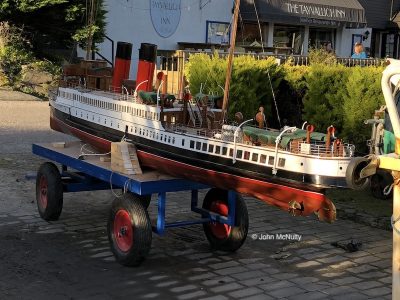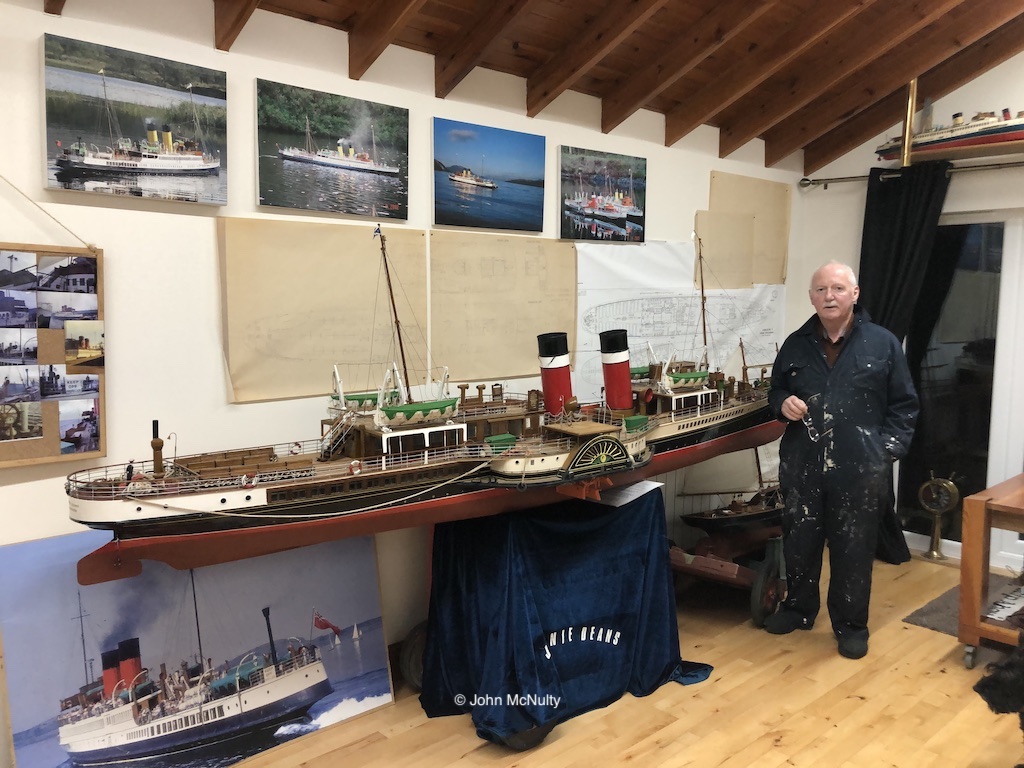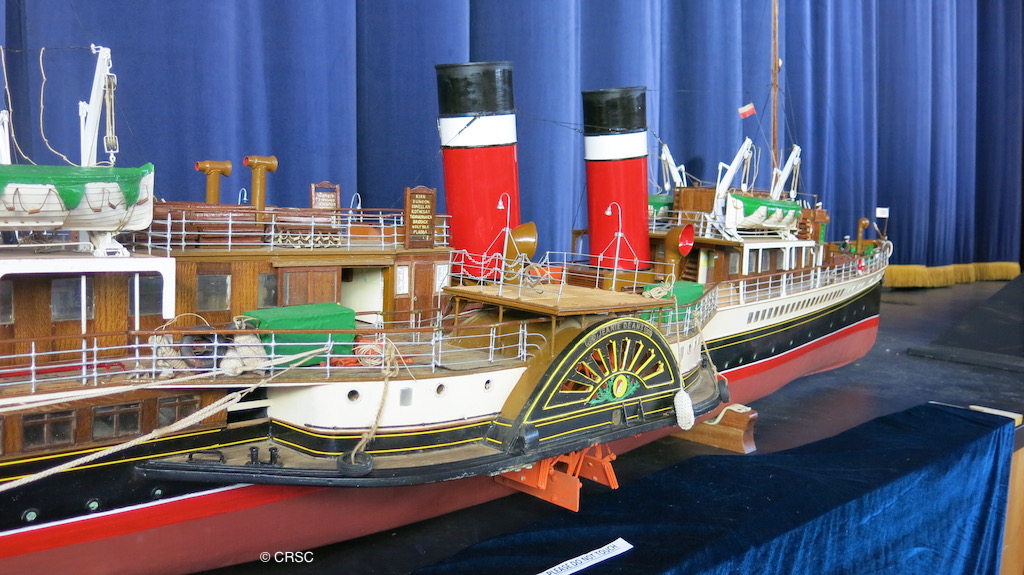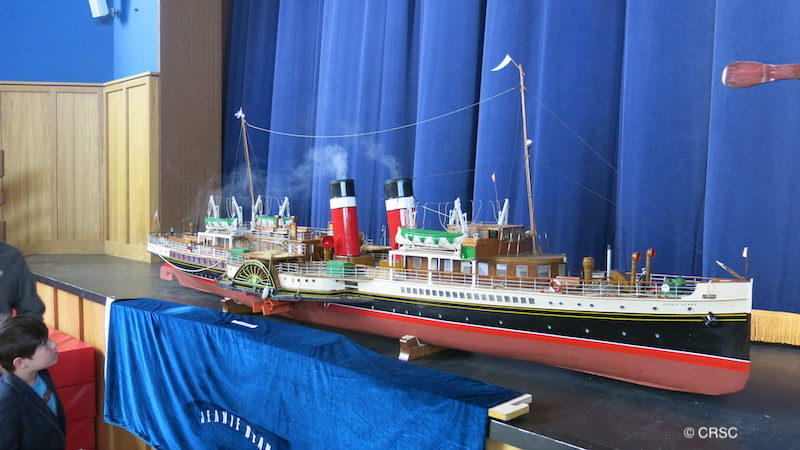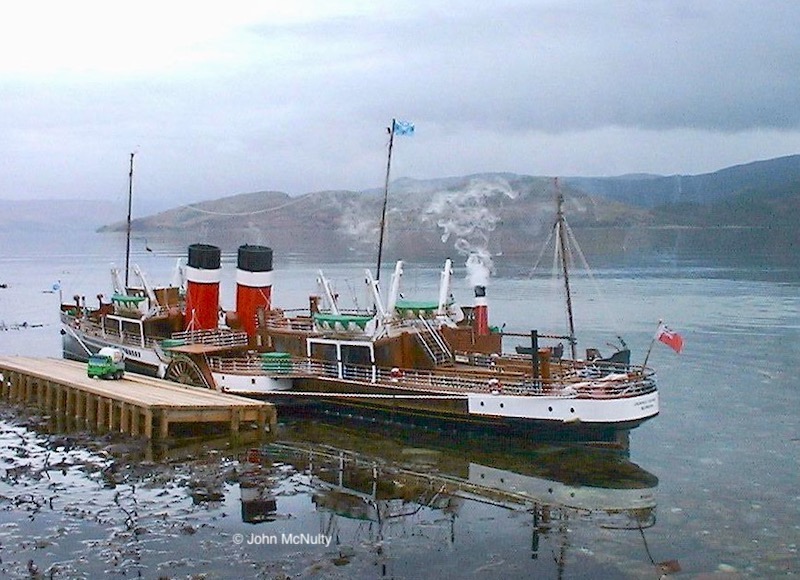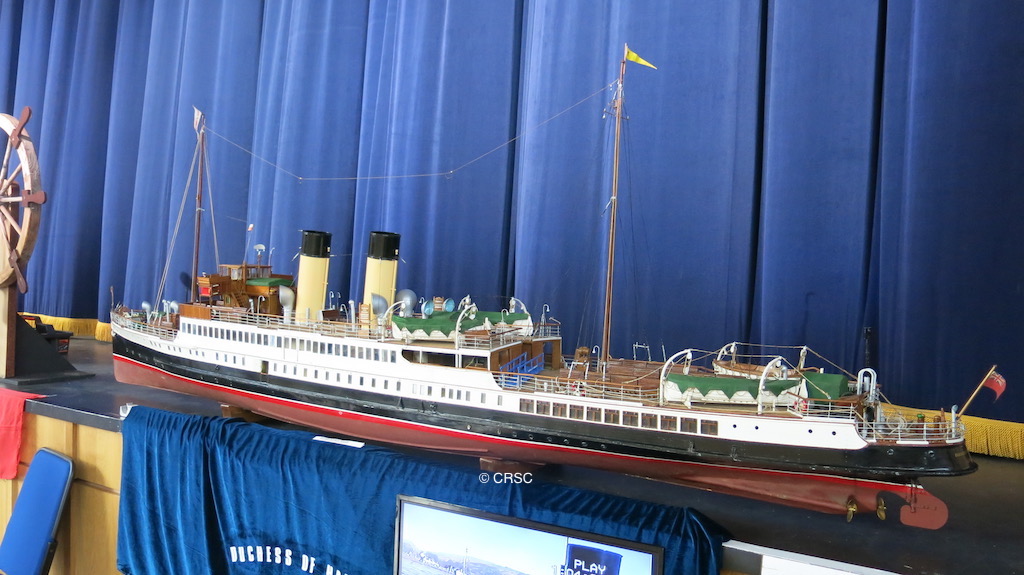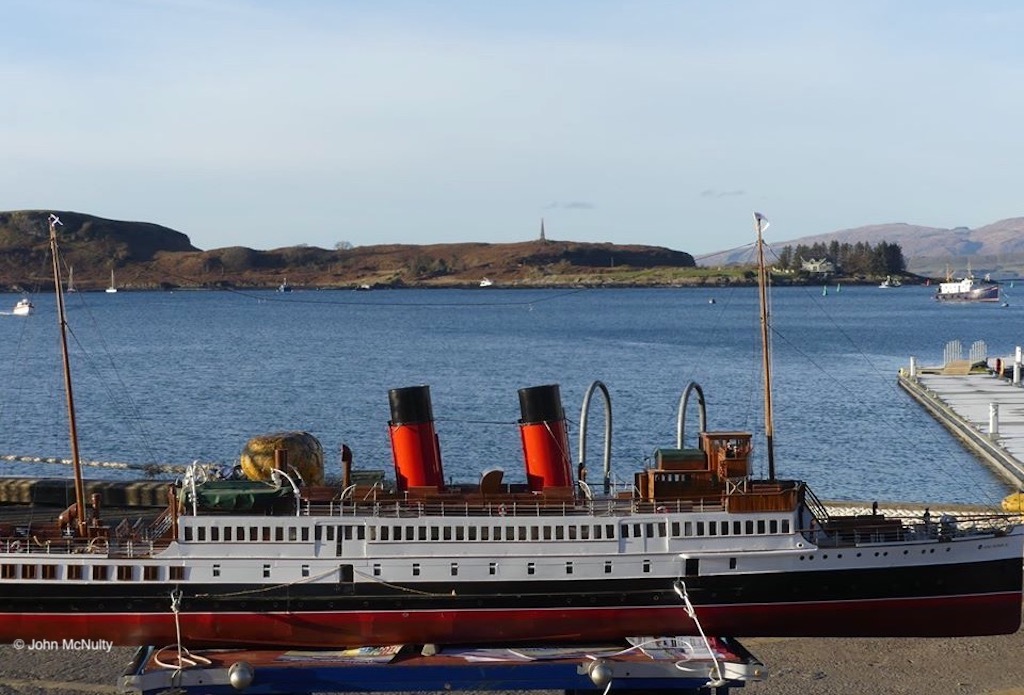
John McNulty’s model of King George V on the waterfront at Oban, with the David Hutcheson monument standing out against the skyline on Kerrera
Four and a half decades after leaving Oban for the last time, King George V was once again the centre of attention at the North Pier last Saturday. Model maker John McNulty put his masterpiece on display in support of the latest Waverley fundraiser, and the MacBrayne turbine proved an irresistible draw. John spoke to CRSC’s Andrew Clark about the skill and art of model-making.
It was a glorious day. The peaks of Mull basked in the sun and the waters of Oban Bay were blue, reflecting a cloudless sky. There, in the middle of it all, was King George V, her red and black funnels glinting with fresh paint.

John McNulty in his workroom with King George V. The model is meticulously based on Denny drawing office plans
There was no sign of the characteristic plumes of steam rising from the two brown vents abaft her funnel, and Iona was not her destination on this occasion.
No, she was staying put on the esplanade, a model of exquisite proportion and finish, looking as if she had just arrived in Oban for a new season.
King George V lives again — not the Denny-built turbine of 1926 that spent most of her life as MacBraynes’ Iona steamer until her withdrawal at the end of the 1974 summer. This ‘King George’ is brand new, a product of model-maker John McNulty’s workshop at his home near Inveraray. He brought her to Oban on Saturday 30 November 2019 to help raise funds for the Waverley Boiler Refit Appeal.
And yes, she attracted a lot of interest. For the best part of 40 years, Oban was KGV’s home. She was a beauty, as John McNulty well knows. He lived and worked in Oban towards the end of her MacBrayne career, and remembers sailing on her to the ‘sacred isle’.
Those memories fuelled John’s re-creation of the ship as a working model, built to a scale of 1/24th (half an inch = one foot). He has tried to make his replica as lifelike as possible, even to the point of powering her by remote control so that she can run in sea water.

‘The weather was so good that we thought we’d sit outside in the station square’: the KGV model (with John McNulty, centre) was a focus of interest for the Waverley Boiler Refit Appeal in Oban on 30 November
His original intention last Saturday was to position the model in the CalMac terminal building, in the hope that some people would drop by. “But the weather was so good that we thought we’d sit outside in the station square, just to see what would happen,” he says.
He and fellow fundraisers ended up on the North Pier, where there just happened to be a political rally. “We got plenty of attention,” John says, “and we saw a lot of money going in to the tin [for the Waverley Appeal].”
Born and brought up at Thornliebank on the south side of Glasgow, John qualified as a pharmacist at Strathclyde University in the 1970s. He eventually bought his own retail pharmacy at Inveraray, later adding a similar business at Lochgilphead. He retired three years ago.
He completed his first ‘big’ model, Duchess of Hamilton, in the early 1970s while still at university: it comes in three sections, the original idea being that he could carry it in a mini van. Jeanie Deans followed in 1978 but, given the demands of family and work, it took John another 40 years to tackle King George V. “Just having three [large models] occupies all my time. I like to keep them in good condition.”
John’s home has two useful spaces — a ‘boat room’ (formerly a garage with access to the driveway), where the models are stored, and a properly heated and insulated workshop. John’s wife refers to the workshop as ‘Lamonts’ after the Greenock shipbuilder/repairer which gave many steamers, including KGV, their annual overhaul in the 1960s and 1970s. He is not planning on building another model, though plenty of people want to commission him to do so.
“They need maintenance,” says John. “They’re working models. People sometimes get too close, and if there’s an accident, it’s a case of having to stick it all back together again.”
Detail is important to John. “Sometimes you sit down and look at a photo, and think ‘I didn’t get that quite right’, and with the ‘King George’, I still have the promenade deck interior and dining room to do: the framework is there but not the detail. I managed to get wee plastic tables and chairs for Jeanie Deans and Duchess of Hamilton, but I need 100 of them for the ‘King George’, so I’m still looking for that. I don’t go as far as putting in knives and forks, but there are always questions, like ‘was it all mahogany and brass?’. The trouble is, when you ask people if they can remember, the details get mixed up in their memory.”
John says the key to a successful model is the builder’s plans. He starts by laying them out on a long table and measuring the length on paper. For King George V, John considers himself lucky to have had access to a set of Denny plans used during her conversion from coal-burning to oil in the early 1950s.
“If you don’t do the hull right, the whole thing is going to be wrong. You have to get the correct sheer, and then you build it like a real ship — starting with the keel, then the frames and the bulkhead so that you have the skeleton of the ship, and then you plate it and work your way up.”
John’s model of Jeanie Deans is made of 4mm plywood, while King George V is aluminium. The funnels, surprisingly, are “quite easy to do”: instead of modelling them on the original 1926 set, slim and round, he opted for the chunkier, elliptically shaped 1935 set, which lasted for the rest of her life. “It’s a case of squeezing the aluminium, which is soft and pliable, and fitting an interior piece to keep them in shape.”
For the stays, he used brassed wire, of the type used for hanging pictures — but choosing the right paint was not so simple. “I went to the Oban Homebase where they have a mixing service for Dulux paints, and asked the young assistant for ‘MacBrayne red’. He looked at me as if I was… [John smiles]. So we went through the charts and found one, something like ‘volcanic ash’, which all the other model makers are now asking me about.”
Recalling his trips to Iona in the early 1970s, John says of the MacBrayne turbine that “she was so well maintained by her West Highland crew that she always looked beautiful and never really showed her age.”
On Oban esplanade last Saturday morning, you couldn’t help feeling that the same ageless beauty lives on in John McNulty’s model.
The Waverley Boiler Refit Appeal is still short of its £2.3m target. To contribute, click here.
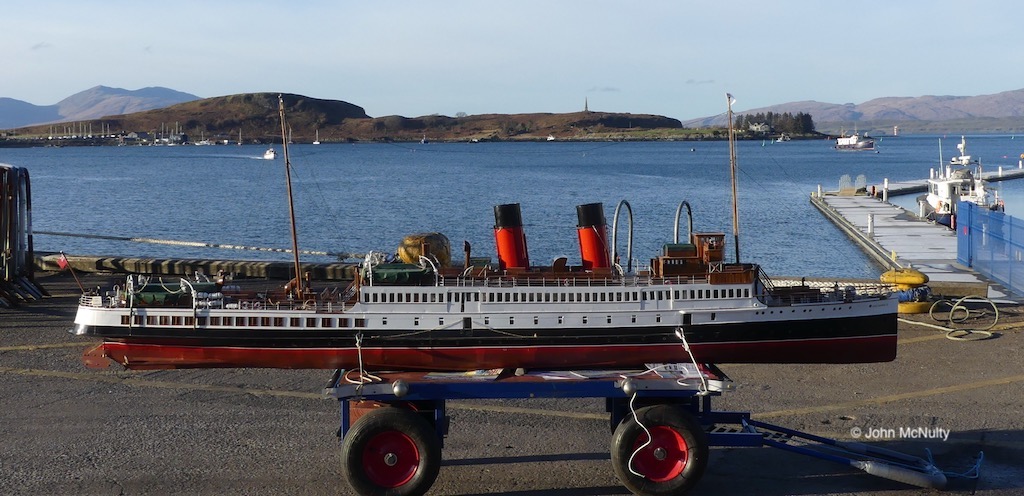
John McNulty’s remarkably life-like model of King George V rekindles memories of one of the most popular steamers in MacBrayne history — an annual fixture for holiday makers at Oban until her withdrawal at the end of the 1974 summer
FURTHER READING:
To Iona by King George V: Douglas McGowan’s memories of a great sail
A tour of the Glasgow Museums ship model storeroom
One Thousand and One Gems from the CRSC Archive: MacBrayne’s Steamers
If you haven’t yet renewed your CRSC subscription for 2019-20, it is now time to do so: click here to pay online. If you are not yet a member, click here for a £10 introductory subscription (‘First Year – Full Membership’) and get all the benefits.
Published on 4 December 2019













